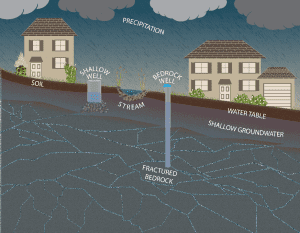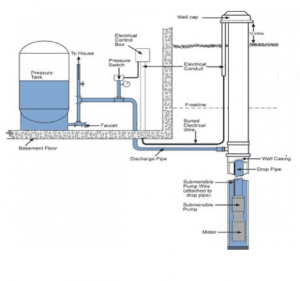Getting To the Bottom of Your Well
Don’t worry, we’ll help you out
Authors: Michael Dietz, Ph.D. and Alec Janis
michael.dietz@uconn.edu
Reviewer: David Dickson (CLEAR)
Publication # EXT057 | January 2024
You turn the faucet on, and water comes out. What else do you need to know? Clean, reliable drinking water is often taken for granted. Understanding where your water comes from at your home is important. The purpose of this fact sheet is to describe how your private residential well works, and to provide advice on how to protect the quality of your water.
Where does groundwater come from?
Water that comes out of your faucet started as rain that fell on the landscape at some point in the past. In Connecticut, most of our groundwater is fairly young (months to several years old). Rain gradually travels down through the upper layers of soil. Most of this groundwater moves slowly by gravity and provides “baseflow” to streams as it enters the stream and river channels. This is why  most streams in our area don’t dry up when it isn’t raining! If you have an older hand-dug shallow well, this is the water you are accessing. When you remove water from a shallow well, water refills that well from the surrounding saturated soil. When you aren’t using water from your shallow well, the water level in the well is the same as the “water table” in the surrounding soil. The water table is the level of water in the saturated soil, and it can fluctuate seasonally. The shallow groundwater level is typically lowest at the end of summer when trees and other vegetation are rapidly pulling water up through their root systems to support photosynthesis. Drought can also affect the shallow groundwater level. For these reasons, shallow hand dug wells are more vulnerable to drying up periodically. They are also more vulnerable to contamination from surface sources, such as agricultural activities or nearby septic systems.
most streams in our area don’t dry up when it isn’t raining! If you have an older hand-dug shallow well, this is the water you are accessing. When you remove water from a shallow well, water refills that well from the surrounding saturated soil. When you aren’t using water from your shallow well, the water level in the well is the same as the “water table” in the surrounding soil. The water table is the level of water in the saturated soil, and it can fluctuate seasonally. The shallow groundwater level is typically lowest at the end of summer when trees and other vegetation are rapidly pulling water up through their root systems to support photosynthesis. Drought can also affect the shallow groundwater level. For these reasons, shallow hand dug wells are more vulnerable to drying up periodically. They are also more vulnerable to contamination from surface sources, such as agricultural activities or nearby septic systems.
Some of the shallow groundwater moves down into the bedrock below, which has many cracks or fractures. As water moves down through these fractures, many surface contaminants are filtered out, and the water also picks up various minerals along its path. Most newer homes in Connecticut will have a well that is drilled into bedrock. A steel casing is installed to prevent shallow groundwater from entering the well. Water then enters the well (essentially a bored hole in the bedrock) from the many fractures in the bedrock. When your well was installed, the well driller made sure that there was enough water in your well for use inside of your home. They were also required to test your well water to make sure that it was potable, or safe to drink (this is the only time that your well water is required to be tested!).
How the system works to provide water inside your home
While older shallow wells often had pumps in the basement of the home, bedrock wells typically have a submersible pump inside the well. This pump pushes water up through a pipe in the well.
The pipe comes through the wall or floor of your basement, where it is connected to a pressure tank, which has a rubber bladder inside that has air pressure on one side. Your pump will push water into the tank until a certain pressure is reached, and a pressure switch will turn off the pump. The bladder in the tank maintains pressure in the system so that when you open a tap in your home, the water will come out. The on/off pressure settings can be adjusted at the pressure switch (best to have a plumber do this).
After the pressure tank, there may be other devices connected to the system. These can include iron filters, water softeners, or other types of treatment systems (see our Well W ater Testing and Treatment fact sheet for more information on the different types of treatment systems).
ater Testing and Treatment fact sheet for more information on the different types of treatment systems).
How can you protect the quality of your water?
While certain aspects of the quality of the water from your well are out of your control, there are actions that you can take to protect the quality of your water: Inspect your well cap regularly. Most residential wells will have a steel casing that sticks out of the ground about 18 inches. There will be a cover on top of this casing that should have a tight seal. If your cap is loose, or if surface water can enter the well casing, you are increasing your chances of contamination. Some older wells have a steel casing that is below grade and has a concrete cover. This type of casing can be more vulnerable to contamination from surface water. Well contractors can extend this casing so the cap is above grade.
Inspect your property and nearby areas to assess potential sources of contamination to your well. Other sources of contamination to your well include failing septic systems, road salt, pesticide/fertilizer use or manure runoff from agricultural operations, or even historic apple orchards. Each of these sources are discussed briefly here:
- Failing septic systems: Look for evidence of black, smelly septic water leaking out on the surface of your lawn. This is an indication that your septic system has potentially failed and needs to be repaired. If this sewage water runs towards your well it can cause contamination as it contains nutrients and bacteria.
- Salt: Take a walk around your property to see if any runoff from rain or melting snow flows from your driveway or the main road to the area of your well. This runoff contains road salt in the winter months, and it can enter your well below the surface of the ground, causing sodium or chloride concentrations to increase in your well. High concentrations of these minerals can cause
 other metals such as lead to leach from pipes or older plumbing fittings. If a problem is observed, contact your town (for local roads) or the state Department of Transportation (for state roads) or property owner (for private roads/lots). You can also reduce the amount of road salt you apply on your own property, if appropriate. Also look for water softener discharges on your property or nearby. These contain concentrated salt brines and can contaminate your well or nearby wells.
other metals such as lead to leach from pipes or older plumbing fittings. If a problem is observed, contact your town (for local roads) or the state Department of Transportation (for state roads) or property owner (for private roads/lots). You can also reduce the amount of road salt you apply on your own property, if appropriate. Also look for water softener discharges on your property or nearby. These contain concentrated salt brines and can contaminate your well or nearby wells.
- Nearby agricultural operations. If fertilizers or pesticides are overapplied to agricultural fields, some of those products can travel into the shallow groundwater, potentially impacting your well. Manure runoff from animal feeding or confinement areas can also be problematic if not contained where it is being generated. Most agricultural producers practice conscientious practices, reducing these types of risks. However, if you or your neighbors have had a known pesticide or nitrate exceedance in the past, it is a good idea to test for these parameters regularly. Owners of older apple orchards often used pesticides such as lead arsenate. The arsenic in this pesticide can persist in soil and shallow groundwater for many years. If you live near an apple orchard that has been in operation for many years, the basic potability test (which now includes arsenic) can help determine if your water has arsenic levels above the health standard.
Test your water regularly! As mentioned above, the quality of your well water can change over time. The state of Connecticut Department of Public Health (CT DPH) recommends testing your water for the basic potability parameters once per year (see guidance at https://ctiwr.uconn.edu/welltesting/). See our Well Water Testing and Treatment fact sheet for more information on testing and treatment. If you are concerned about other contaminants such as pesticides, petroleum products or other chemical constituents, you can contact one of the State certified testing labs to get pricing and instructions. See the map on their website.
Maintain treatment systems, if present. Become aware of the type of maintenance needed for your treatment devices if you have any. Sediment and iron filters will need to be changed at an interval that depends on the pore size of the filter, how much water is used, and how much sediment is in your water. Water softeners will need to have salt added to the reservoir at an interval that depends on the hardness of your water and the regeneration settings of your system. **One note on water softeners: these systems have been commonly used in homes where water was not excessively hard and they discharge concentrated salt brines to your property. As mentioned, this salt brine can contaminate your well or other wells nearby. Test the quality of your raw water to determine if a softener is necessary.
